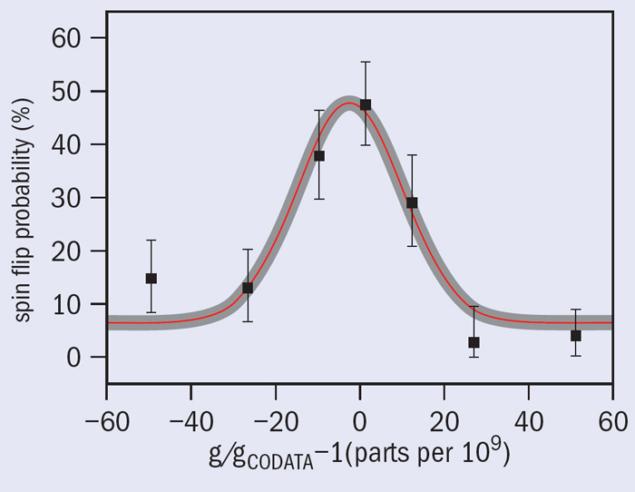
Image credit: Georg Schneider.
A German/Japanese collaboration working at the University of Mainz has performed the first direct high-precision measurement of the magnetic moment of the proton – which is by far the most accurate to date. The result is consistent with the currently accepted value of the Committee on Data for Science and Technology (CODATA), but is 2.5 times more precise and 760 times more accurate than any previous direct measurement. The techniques used will feature in the Baryon-Antibaryon Symmetry Experiment (BASE) – recently approved to run at CERN’s Antiproton Decelerator (AD) – which aims at the direct high-precision measurement of the magnetic moments of the proton and the antiproton with fractional precisions at the parts-per-billion (ppb) level, or better.
Prior to this work, the record for the most precise measurement of the proton’s magnetic moment had stood for more than 40 years. In 1972, a group at Massachusetts Institute of Technology measured its value indirectly by performing ground-state hyperfine spectroscopy with a hydrogen maser in a magnetic field. This experiment measured the ratio of the magnetic moments of the proton and the electron. The results, combined with theoretical corrections and two additional independent measurements, enabled the calculation of the proton magnetic moment with a precision of about 10 parts in a billion.
In an attempt to surpass the record, the collaboration of scientists from Mainz University, the Max Planck Institute for Nuclear Physics in Heidelberg, GSI Darmstadt and the Japanese RIKEN institute applied the so-called double Penning trap technique to a single proton for the first time (see figure 1). One Penning trap – called the analysis trap – is used for the non-destructive detection of the spin state, through the continuous Stern-Gerlach effect. In this elegant approach, a strong magnetic inhomogeneity is superimposed on the trap, so coupling the particle’s spin-magnetic-moment to its axial oscillation frequency in the trap. By measuring the axial frequency, the spin quantum state of the trapped particle can be determined. And by recording the quantum-jump rate as a function of a spin-flip drive frequency, the spin precession frequency νL is obtained. Together with a measurement of the cyclotron frequency νc of the trapped particle, the magnetic moment of the proton μp is obtained finally in units of the nuclear magneton, μp/μN = νL/νc.

Image credit: Andreas Mooser.
This approach has already been applied with great success in measurements of the magnetic moments of the electron and the positron. However, the magnetic moment of the proton is about 660 times smaller than that of the electron, so the proton measurement requires an apparatus that is orders of magnitude more sensitive. To detect the proton’s spin state, the collaboration used an extremely strong magnetic inhomogeneity of 300,000 T/m2. However, this limits the experimental precision in the frequency measurements to the parts-per-million (ppm) level. Therefore a second trap – the precision trap – was added about 45 mm away from the strong magnetic-field inhomogeneity. In this trap the magnetic field is about 75,000 times more homogeneous than in the analysis trap.
To determine the magnetic moment of the proton, the first step was to identify the spin state of the single particle in the analysis trap. Afterwards the particle was transported to the precision trap, where the cyclotron frequency was measured and a spin flip induced. Subsequently the particle was transported back to the analysis trap and the spin state was analysed again. By repeating this procedure several hundred times, the magnetic moment was measured in the homogeneous magnetic field of the precision trap. The result, extracted from the normalized resonance curve (figure 2), is the value μp = 2.792847350(9)μN, with a relative precision of 3.3 ppb.
In the BASE experiment at the AD the technique will be applied directly to a single trapped antiproton and will potentially improve the currently accepted value of the magnetic moment by at least a factor of 1000. This will constitute a stringent test with baryons of CPT symmetry – the most fundamental symmetry underlying the quantum field theories of the Standard Model of particle physics. CPT invariance implies the exact equality of the properties of matter–antimatter conjugates and any measured difference could contribute to understanding the striking imbalance of matter and antimatter observed on cosmological scales.
Further reading
A Mooser et al. 2014 Nature 509 596







